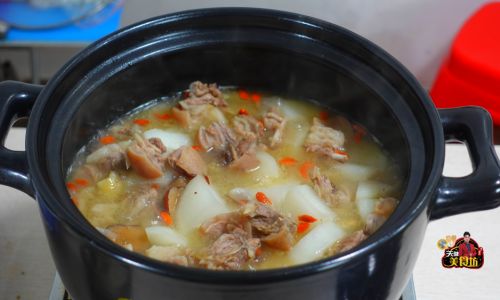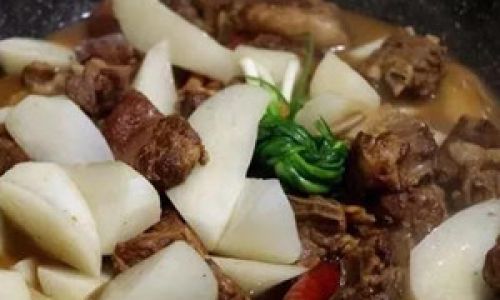Introduction
In the realm of culinary delights, traditional dishes often hold a special place, not just for their taste but also for the warmth and nostalgia they evoke. One such dish that stands out in many cuisines, especially in colder climates, is mutton stew with radish. This hearty meal combines the rich, earthy flavor of mutton with the sweetness and subtle crunch of radish, creating a symphony of textures and tastes that is both comforting and satisfying. Whether you’re a seasoned chef or a home cook looking to impress, mastering the art of making delicious mutton stew with radish can be a rewarding endeavor. This guide will take you through every step, from selecting the best ingredients to perfecting the cooking process, ensuring that your stew is not just good but truly exceptional.
Section 1: Understanding the Ingredients
1 Mutton: The Star Ingredient

Mutton, the flesh of adult sheep, is known for its robust, slightly gamy flavor and its ability to absorb flavors during cooking. When choosing mutton for stew, look for cuts that are well-marbled and have a good balance of fat and lean meat. Shoulder, neck, and breast are ideal cuts for stewing as they contain enough collagen to keep the dish moist and tender. Fresh mutton is preferable, but if using frozen, ensure it is thawed properly before use.
2 Radish: The Essential Complement
Radishes, often overlooked in complex dishes, add a refreshing sweetness and slight crunch to mutton stew. They also help balance the richness of the mutton. When selecting radishes, opt for firm, smooth-skinned varieties such as daikon or white radishes. Avoid those with soft spots or cracks, as they may be past their prime. Fresh radishes should be used for the best flavor and texture.
3 Aromatics and Seasonings
The key to a flavorful mutton stew lies in the aromatics and seasonings. Essential ingredients include onions, garlic, ginger, and fresh herbs like parsley, thyme, or rosemary. These not only enhance the taste but also add depth and complexity to the dish. For seasoning, salt and pepper are basics, but you can also experiment with spices like cumin, coriander, and paprika to suit your palate.
4 Broth and Liquid
A good broth is crucial for a successful stew. You can use homemade mutton or beef broth for the best results, but high-quality store-bought broth can also work. Water can be used, but it will lack the richness and flavor that broth provides. Additionally, a splash of red wine or beer can add another layer of complexity to the stew.
Section 2: Preparation Techniques
1 Preparing the Mutton
Before cooking, trim any excess fat from the mutton pieces to prevent the stew from becoming too greasy. Season the meat generously with salt and pepper. For added flavor, you can marinate the meat in a mixture of olive oil, garlic, and herbs for a few hours or overnight. This will help the meat absorb the flavors and tenderize it slightly.
2 Preparing the Radishes and Aromatics
Peel and chop the radishes into bite-sized pieces. Peel and finely chop the onions, garlic, and ginger. This ensures they cook evenly and release their flavors into the stew. Fresh herbs should be tied into a bouquet garni or finely chopped, depending on when you plan to add them.

3 Searing the Mutton
In a heavy-bottomed pot or Dutch oven, heat a little oil over medium-high heat. Sear the mutton pieces until they are browned on all sides. This not only locks in juices but also adds a layer of caramelized flavor to the stew. Remove the meat from the pot and set it aside.
Section 3: Cooking the Stew
1 Building the Flavor Base
In the same pot used to sear the mutton, add the chopped onions, garlic, and ginger. Sauté until the onions are translucent and the aromatics are fragrant. This creates the foundation of flavor for your stew.
2 Adding the Broth and Seasonings
Deglaze the pot with a bit of broth or wine, scraping up any browned bits from the bottom. This adds extra flavor to the stew. Return the seared mutton to the pot, along with the chopped radishes. Pour in enough broth to fully submerge the ingredients, then add your seasonings and aromatics. If using a bouquet garni, add it now. Bring the mixture to a simmer.
3 Slow Cooking for Tenderness
The beauty of mutton stew lies in its slow cooking. Lower the heat to maintain a gentle simmer and cook, uncovered, for about an hour. This allows the flavors to meld and the meat to start tenderizing. After an hour, cover the pot and reduce the heat to the lowest setting. Let the stew cook for another 2-3 hours, or until the meat is very tender and can be easily pulled apart with a fork.
4 Finishing Touches
During the final 30 minutes of cooking, taste the stew and adjust the seasoning as needed. If the stew is too thick, add more broth; if it’s too thin, remove the lid and let some of the liquid evaporate. Add the freshly chopped herbs in the last 10 minutes of cooking to preserve their bright flavors.
Section 4: Serving and Enjoying

1 Serving Suggestions
Once the stew is cooked to perfection, remove the bouquet garni if used. Serve the mutton stew with radish over a bed of cooked grains like barley or quinoa, or with crusty bread to soak up the delicious broth. A side of steamed greens or a simple salad can provide a refreshing contrast to the rich stew.
2 Pairing Wines and Beverages
A full-bodied red wine, such as a Cabernet Sauvignon or Merlot, pairs well with the rich flavors of the stew. For a non-alcoholic option, a hearty beer or a spiced cider can also complement the dish.
Section 5: Tips and Variations
1 Tips for Perfect Stew
- Patience is Key: Slow cooking is essential for tender, flavorful mutton. Rushing the process will result in tough meat and a less developed flavor.
- Use Quality Ingredients: Fresh, high-quality ingredients make a significant difference in the final taste of the stew.
- Don’t Overcrowd the Pot: Ensure there’s enough space for the broth to circulate around the meat and vegetables. Overcrowding can result in uneven cooking.
2 Variations to Try
- Add Root Vegetables: Incorporate other root vegetables like carrots, turnips, or parsnips for added color, texture, and nutrition.
- Use Different Herbs and Spices: Experiment with herbs like cilantro, mint, or dill, or spices like turmeric, cardamom, or cloves to create unique flavor profiles.
- Make it Spicy: For a spicy kick, add diced chili peppers or a sprinkle of red pepper flakes.
Conclusion
Mutton stew with radish is a timeless dish that combines simplicity and sophistication. By following the steps outlined in this guide, you can create a stew that is not only nutritious and comforting but also bursting with flavor. Whether you’re cooking for a family dinner, entertaining friends, or simply treating yourself, this dish promises to deliver an unforgettable culinary experience. Remember, the key to mastering any recipe is practice and experimentation. With each attempt, you’ll learn more about your preferences and how to tweak the recipe to suit your taste. Happy cooking, and enjoy your delicious mutton stew with radish!





0 comments